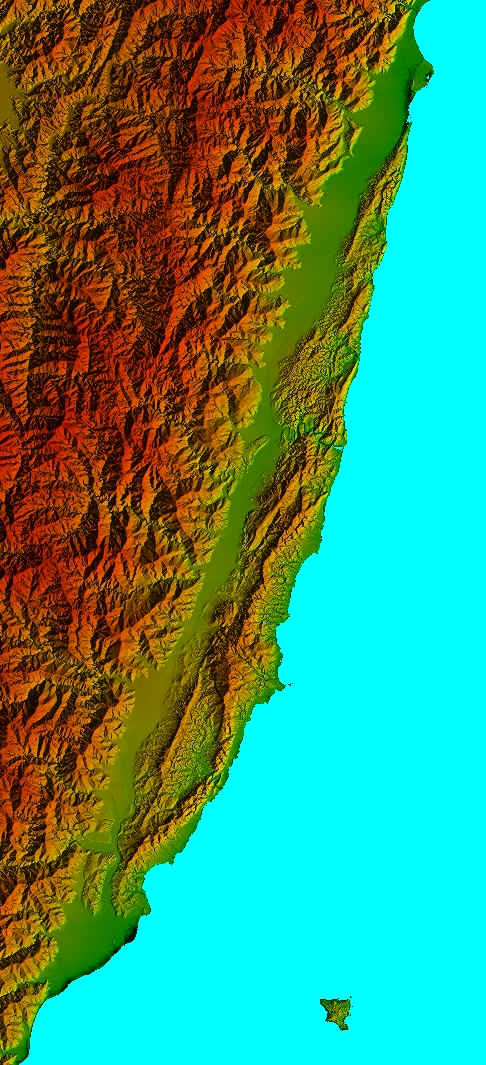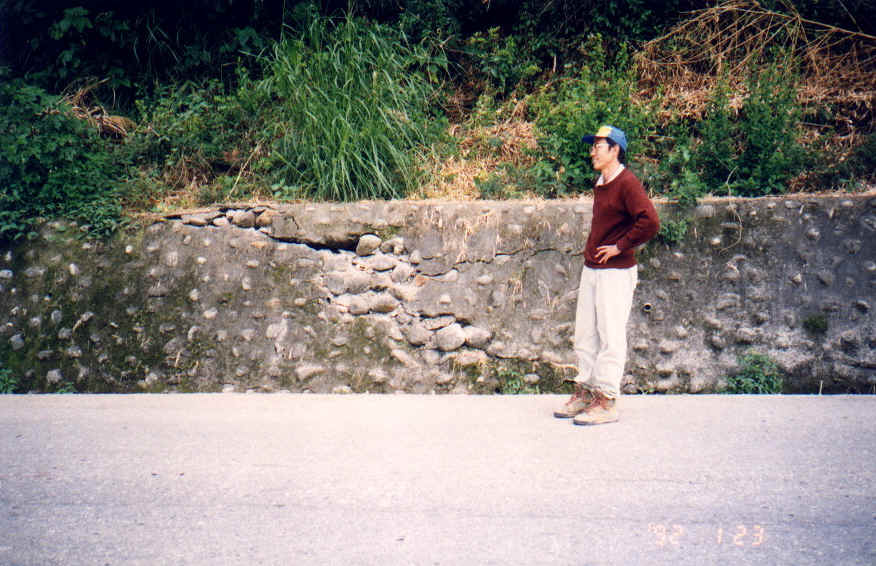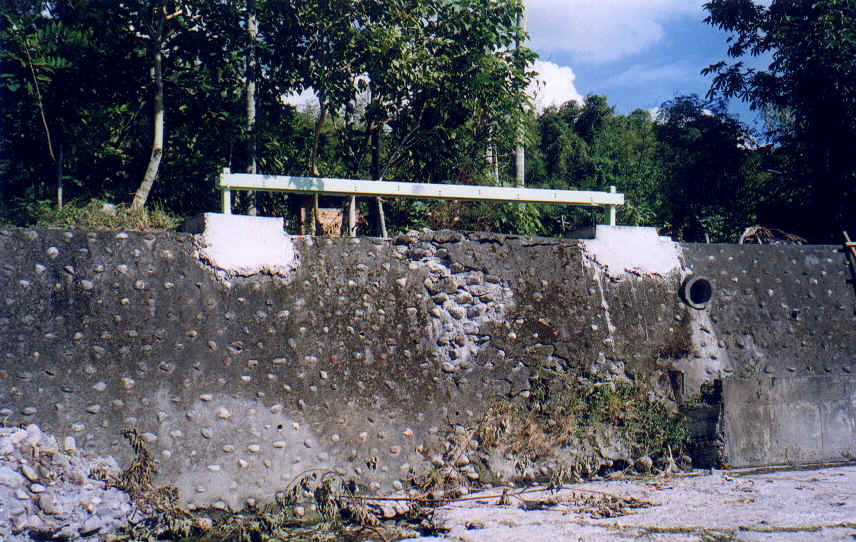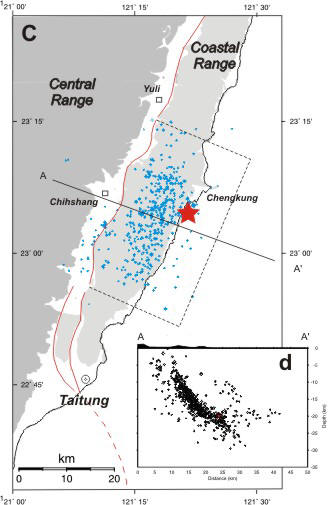 The Longitudinal
Valley in eastern Taiwan represents the present plate suture between Eurasian
and Philippine plates. How is the
significant deformation (more than 2 cm/yr horizontal shortening across the
Longitudinal Valley) distributed across the plate suture valley, and how much
attributed to a single major fault zone are
our main questions.
The Longitudinal
Valley in eastern Taiwan represents the present plate suture between Eurasian
and Philippine plates. How is the
significant deformation (more than 2 cm/yr horizontal shortening across the
Longitudinal Valley) distributed across the plate suture valley, and how much
attributed to a single major fault zone are
our main questions.
A geodetic measurement using trilateration network (by Yu S.B. and his colleagues) carried out in 1983-1988 first showed a substantial horizontal shortening occurred across the LVF. Based on these data, we carried out a further analysis by introducing a discontinuous rigid-block model so that the location of fault zone as well as the moving vectors can be defined [Lee and Angelier, 1993].
 We carried out geological field investigations along the active Chihshang active fault,
one of the most active segments of the LVF, for
characterizing and measuring the fault motion at the outcrops.
Concrete
retaining walls, which revealed thrust-type surface ruptures of the creeping
Chihshang fault, provide a good opportunity for the outcrop quantitative
analysis. We obtained a
steady shortening rate of about 2 cm/yr during 1990-2000. The surface rupture
of active faulting concentrated within a 30-100-m-wide narrow deformation
zone. [Angelier et
al., 1997; Angelier et al., 2000]
We carried out geological field investigations along the active Chihshang active fault,
one of the most active segments of the LVF, for
characterizing and measuring the fault motion at the outcrops.
Concrete
retaining walls, which revealed thrust-type surface ruptures of the creeping
Chihshang fault, provide a good opportunity for the outcrop quantitative
analysis. We obtained a
steady shortening rate of about 2 cm/yr during 1990-2000. The surface rupture
of active faulting concentrated within a 30-100-m-wide narrow deformation
zone. [Angelier et
al., 1997; Angelier et al., 2000]
 Strain partitioning on the southern Longitudinal Valley
Strain partitioning on the southern Longitudinal Valley
 We developed
rod-type creepmeters and set up across the surface breaks for monitoring of the creeping Chihshang
fault [Lee et al., 2000]. One-year
results (1998-1999) reveal that the surface deformation of the Chihshang
fault, though distributed, continuously moving along the surface ruptures.
This annually steady motion also confirmed the result from previously field investigation.
On the other hand, the detailed creep data, revealed by creepmeters, shows a seasonal
variation of fault motion which was closely linked to the rainfall [Lee
et al., 2001; Lee et al., 2003].
We developed
rod-type creepmeters and set up across the surface breaks for monitoring of the creeping Chihshang
fault [Lee et al., 2000]. One-year
results (1998-1999) reveal that the surface deformation of the Chihshang
fault, though distributed, continuously moving along the surface ruptures.
This annually steady motion also confirmed the result from previously field investigation.
On the other hand, the detailed creep data, revealed by creepmeters, shows a seasonal
variation of fault motion which was closely linked to the rainfall [Lee
et al., 2001; Lee et al., 2003].
 Local
geodetic networks were deployed at five
Local
geodetic networks were deployed at five
 The
2003 Mw=6.5 Chengkung earthquake resulted from rupturing of the Chihshang
fault. The main shock together with numerous aftershocks likely distributed
along a fault patch of 35 km long and 25 km wide. Combining the far field
GPS data with our near fault investigation, including field observation,
measurements on local geodetic networks (GPS, leveling and distance-angle),
creep meters, we found a much larger post-seismic slip occurred along the
surface ruptures of the Chihshang fault, compared to a smaller co-seismic
slip [Lee et al., 2006].
The
2003 Mw=6.5 Chengkung earthquake resulted from rupturing of the Chihshang
fault. The main shock together with numerous aftershocks likely distributed
along a fault patch of 35 km long and 25 km wide. Combining the far field
GPS data with our near fault investigation, including field observation,
measurements on local geodetic networks (GPS, leveling and distance-angle),
creep meters, we found a much larger post-seismic slip occurred along the
surface ruptures of the Chihshang fault, compared to a smaller co-seismic
slip [Lee et al., 2006].
Below publications list our efforts on Active Tectonics of the LVF
Lee, J.C. & Angelier, J., 1993. Localisation des déformations actives et traitements des données géodésiques: l'example de la faille de la Vallée Longitudinal, Taïwan. Bull. Soc. géol. France, t. 164, n° 4, pp. 533-540. (SCI)
Yu, M.S., Chu, H.T., Hou, C.S., and Lee, J.C., 1994. The Chengkung earthquake of May 29, 1992 and the Chihshang Fault (in Chinese): Bull. Cent. Geol. Sur., v. 9, 107-121.
Angelier, J., Chu, H.T., and Lee, J.C., 1997. Shear concentration in a collision zone: kinematics of the active Chihshang Fault, Longitudinal Valley, eastern Taiwan: Tectonophysics, 274, 117-144. (SCI) [Full Text (PDF)]
Lee, J.C., Angelier, J., Chu, H.T., Yu, S.B., and Hu, J.C., 1998. Plate-boundary strain partitioning along the sinistral collision suture of the Philippine and Eurasian plates: Analysis of geodetic data and geological observation in southeastern Taiwan: Tectonics, 17, 6, 859-871. (SCI) [Full Text (PDF)]
Lee, J.C., Jeng, F.S., Chu, H.T., Angelier, J. and Hu, J.C., 2000. A rod-type creepmeter for measurement of displacement in active fault zone: Earth, Planets, and Space, 52, 5, 321-328. (SCI) [Full Text (PDF)]
Angelier, J., Chu, H.T., Lee, J.C., and Hu, J.C., 2000. Active faulting and earthquake risk: the Chihshang Fault case, Taiwan: Jour. Geodynamics, 29, 151-185. (SCI) [Full Text (PDF)]
Lee, J.C., Angelier, J., Chu, H.T., Hu, J.C., and Jeng, F.S., 2001. Continuous monitoring of an active fault in a plate suture zone: a creepmeter study of the Chihshang active fault, eastern Taiwan, Tectonophysics, 333, 219-240. (SCI) [Full Text (PDF)]
Chow,
J., Angelier, J., Hua, J.J., Lee, J.C., and Sun, R., 2001. Paleoseismic
event and active faulting: from ground penetrating radar and high-resolution
seismic reflection profiles across the Chihshang Fault, eastern Taiwan, Tectonophysics,
333, 241-259. (SCI)
Hu, J.C., Angelier, J., Homberg, C., and Lee, J.C., 2001. Three-dimensional modeling of the behavior of the oblique convergent boundary of southeast Taiwan: friction and strain partitioning, Tectonophysics, 333, 261-276. (SCI) [Full Text (PDF)]
Lee, J.C.,
Chu, H.T., Angelier, J., Hu, J.C., Yu, S.B., Chen, H.Y., Jeng, F.S. Lin, C.H.,
Rau, R.J., Chow, J.D., Chang, S.H., and Jiang, G.C., 2002. Crustal deformation
and Active faulting in relation with seismic hazard: Study of the active
Chihshang fault in
Lee, J.C., Angelier, J., Chu, H.T., Hu, J.C., Jeng, F.S. and Rau, R.J., 2003. Active Fault Creep Variations at Chihshang, Taiwan, Revealed by Creepmeter Monitoring, 1998-2001. Journal of Geophysical Research, 108, B11, 2528, doi:10.10129/2003JB002394. (SCI) [Full Text (PDF)11.2MB]
Lee, J.-C., J. Angelier, Chu, H.T., Hu, J.C., Fu-Shu Jeng, 2005. Monitoring active fault creep as a tool in seismic hazard mitigation. Insights from creepmeter study at Chihshang, Taiwan, C.R. Geosciences, 337(13), 1200-1207. (SCI) [Full Text (PDF) 950K]
Lee, J.-C.,
Chu, H.T., J. Angelier, Hu, J.C., Chen, H.Y., Yu, S.B., 2006. Quantitative
analysis of co-seismic surface faulting and post-seismic creep accompanying the
2003, Mw=6.5, Chengkung earthquake in eastern
Taiwan,
Hu, J.C., Cheng, L.-W. Chen, H.-Y., Wu, Y.-M., Lee, J.-C., Chen, Y.-G., Lin, K.-C., Rau, R.-J., Kuochen, H., Chen, H.-H., Yu, S.-B., Angelier J., 2007. Coseismic deformation revealed by inversion of strong motion and GPS data: the 2003 Chengkung earthquake in eastern Taiwan. Geophys. J. Int., 169, 667-674, doi: 10.1111/j.1365-246X.2007.03359.x. (SCI) [Full Text (PDF) 11.9MB]